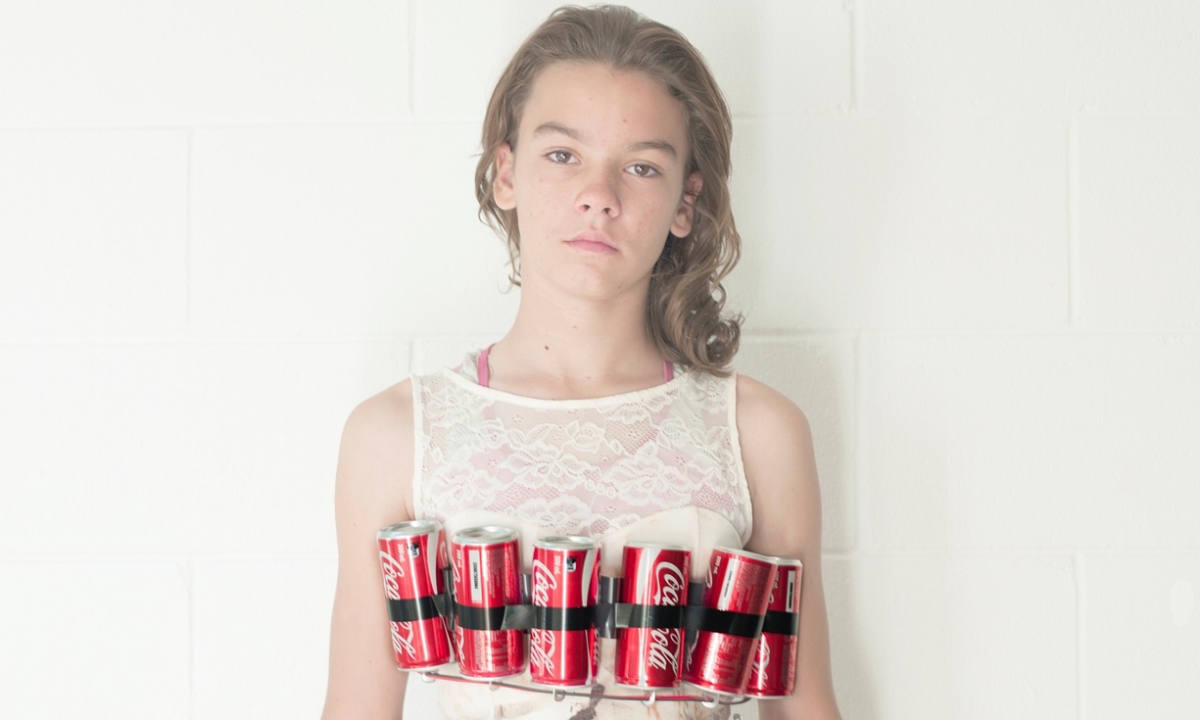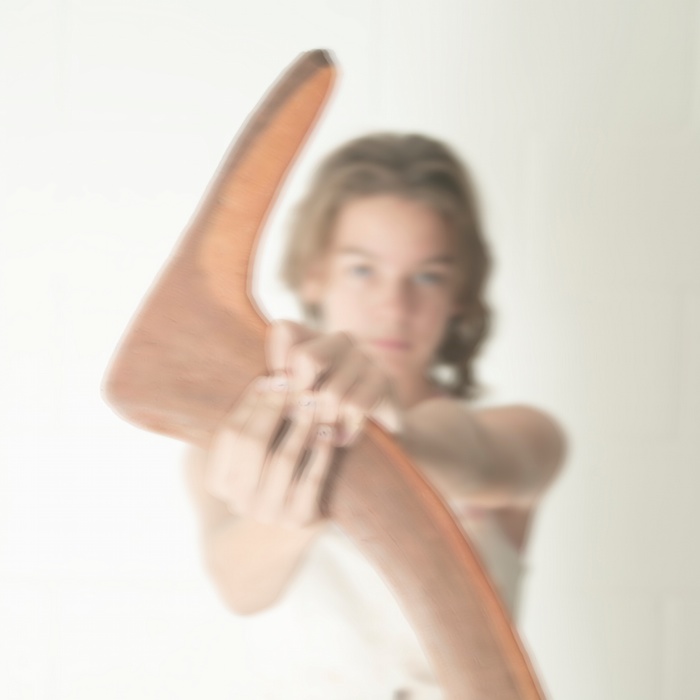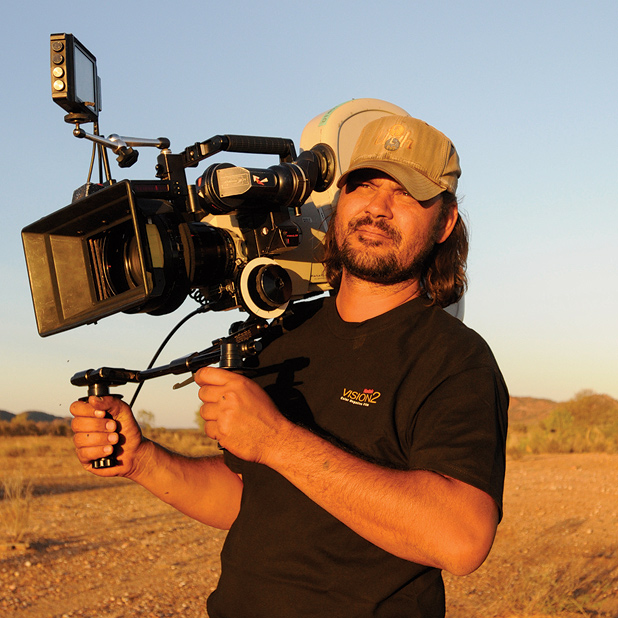In a recent exhibition at the Anna Schwartz Gallery in Melbourne, Australian film director and photographer Warwick Thornton (Samson and Delilah) brings attention to the future of children’s health in low-income Indigenous communities.
The images are shocking, stark and honest. In Thornton’s recent exhibition entitled The Future is Unforgiving, Aboriginal children pose wearing ‘suicide vests’ made of tape, fast-food boxes and Coke cans.
In many low-income Aboriginal communities, water is unsafe and soft drinks are an affordable alternative. Healthy fruits and vegetables are often priced extremely highly, so fast-food consumption becomes the norm.
The effects on these children’s lives can be devastating. According to the Australian Institute of Health and Welfare, 3000 Indigenous Australians die prematurely each year, primarily from diseases including cancer, diabetes, cardiovascular disease and gastrointestinal diseases.
For Thornton this project was personal, and the children who appeared in the photographs are all his relatives, from his hometown of Alice Springs. Thornton said:
“I spoke to them and told them this was fictional, and told them about what I was doing. Because they are related to me I have ongoing access to them, so if at 15 or 22 they have questions that come up about the works, I can still explain to them the meaning and keep talking to them.”
Professor Marcia Langton AM, holder of the Foundation Chair in Australian Indigenous Studies at the University of Melbourne in the Faculty of Medicine and recipient of the Order of Australia Medal, said in her treatise about the exhibition:
“In the first image of the second diptych, Sterling, an Aboriginal boy wears a suicide vest of fast food containers from the ubiquitous global chain, McDonalds. His fate of obesity and ill health already appear in his physique. In the second image the boy holds a traditional hunting toy, a slingshot, and his image is blurred. Instead of learning to hunt, he self harms with fast food, and his socialisation is bereft of traditions such as hunting and bereft of the vast knowledge of his traditional estate, environments, fauna and flora, his rightful patrimony.”
She continued:
“In the third diptych, Luka, firstly, a young woman wears a suicide vest of Coca-Cola cans, and in the paired image, she holds a ‘number 7’ boomerang, the most efficient and deadly of all boomerangs. The same could be said of Coca-Cola, which medical professionals suspect contributes to the high levels of diabetes in the indigenous populations of Australia.”
Gallery founder Anna Schwartz spoke passionately about the exhibition:
“It looks at the universal simplicity and sweetness and positivity of children, and lays before us what will become of their lives. It is uncomfortable, because we are all agents in that future.”
Aunty Kerrie Doyle, associate professor of Indigenous Health at RMIT University, praised Thornton for the insightful and brave photographs. She spoke plainly about her work in rural Western Australia, where “they sell lettuce by the leaf and oranges cost five dollars each.” She said of Thornton’s exhibition:
“I think it speaks to his passion for his people, it speaks to his passion to try and make a difference to the long-term health of Indigenous people, and I think it speaks to his courage, because there will people who criticise him for doing this, these are stories some people don’t want to hear.”
Dr. Tim Senior, who has worked closely with rural Indigenous communities, also commended Thornton on the exhibition. “Indigenous people have a better feeling of what messages will have an impact than we do.”
He explained the situation in detail:
“Indigenous children learned to gather and prepare food from their grandparents, and that link is cut from the stolen generation, they don’t have that knowledge of hunting and gathering passed down to them. Instead, they grew up with junk food. Food isn’t just a topic of science and nutrition, it’s about cultural connection.”
And while artists like Thornton are bringing much-needed attention to the issue with powerful photography, scientists are banding with them to work on solutions. Senior suggested:
“I think another option to address the health issues being faced by Indigenous communities is to reclaim original food gathering practices, and getting local, small scale agriculture going in those areas where it is possible to do so.”
And it’s as necessary as ever. According to the Victorian government’s latest Aboriginal affairs report, rates of Aboriginal Victorians who are overweight and obese have risen from 48 to 64 per cent over the past decade.
The Guardian got in touch with a spokeswoman from McDonald’s, who said that the company was working to improve the nutritional value of its food with an awareness of community issues.
“We will continue to work with government, industry and health professionals to develop ongoing strategies to address community concerns.”
Thornton’s work is about his people, his homeland and those closest to him. His impactful exhibition brings limelight to this key Australian issue with the clarity and honesty needed to address it. Viewing Thornton’s photographs, we can be reminded not only of such issues, but also of the power of art made with integrity and purpose.
As Professor Langton said in her treatise:
“The video, The Future is Unforgiving, simply shows, without artifice, the innocence, the natural grace, the optimism, innate in the state of childhood, with all its human potential. This also a portrait of the viewer and their social responsibility to allow these young lives to flourish unimpeded by the known destructive elements presented in the photographs.
“The power of Warwick Thornton’s imagery, whether in cinematic or photographic works, is in how he plays with ideas of time, space and identity; the power of the Aboriginal story; the burden of the historical injustices; and so clearly here, the power of the Aboriginal presence, with all its horror and beauty, in Australia.”














